Usually reserved for the rulers and legislators, parliaments are difficult to put a price on, but not impossible. Their actual value comes from more than just construction costs and location; it has much more to do with their political importance. Yet, while being essentially priceless, parliament buildings can be valued: strip them of their political, cultural, and symbolic role, and you will have a piece of real estate that can be sold and bought on the market.
Curious to compare these landmarks by real estate value alone, the team at TradingPlatforms estimated their hypothetical market price using total floor area and current average prices. We focused on the parliament buildings of 30 European countries and calculated the price of each building as if it were listed on the market right now.
Key takeaways
- The Palais Bourbon in Paris is the most valuable parliament building in Europe, with an estimated worth of nearly €2 billion thanks to its enormous size and location in one of the world’s most expensive property markets.
- While Romania’s colossal Palace of the Parliament boasts by far the largest floor area (365,000 m²), its location in a cheaper property market puts its estimated value below €1 billion, less than half the price of smaller but better-located rivals.
- With a modest floor area of 2,200 m² and local property prices around €4,510 per m², Slovenia’s parliament has an estimated value of just under €10 million, making it one of Europe’s smallest and least costly parliamentary buildings.
Estimated Market Value of Parliament Buildings Across Europe in 2025
*Estimates based on average nearby real estate prices per square metre and building size, covering 30 EU and UK countries.
Data sources: Investropa,Local real estate websites,Google Earth,Wikipedia
The “value” of a building isn’t just about bricks and steel – it also reflects location, symbolic weight, commercial viability, and in some cases, cultural identity. Parliament buildings, in particular, are not among the priciest structures ever built. This title is reserved for places of cultural and religious significance. The Great Mosque of Mecca, whose construction is believed to have begun in the 630s, is now universally considered the most valuable building in the world with an estimated cost of well over US$100 billion.
But what would be the market value of some of Europe’s most iconic seats of democracy? If we leave out their historical and political significance and put them on sale today, they would fetch quite surprising values.

Europe’s parliament buildings vary dramatically in hypothetical market value, influenced not only by their size but also by the soaring real estate prices in the cities where they are located. Paris’s Palais Bourbon tops the list at €1.92 billion for 124,000 m², reflecting the city’s high average property prices of €15,500 per m².
Remarkably, Vienna’s Austrian Parliament, at just 55,000 m², is estimated at €1.37 billion, thanks to its location on the Ringstraße, Vienna’s famous circular boulevard in the city centre, where average property prices reach an exceptionally high €24,977 per m². This makes it nearly as valuable as the much larger Palace of Westminster (€1.55 billion for 112,476 m²) despite being half its size.
By contrast, Romania’s colossal Palace of the Parliament in Bucharest, with a floor area of 365,000 m², is valued at only €751.5 million, ranking fifth due to Bucharest’s modest average property prices of €2,059 per m². The actual cost of the construction, which took 15 years to complete and was calculated in 2025 Euros, is approximately €4 billion.
Smaller parliaments in less expensive markets, such as Slovenia’s National Assembly (€9.92 million, 2,200 m²) and Latvia’s House of the Livonian Noble Corporation (€17.24 million, 7,500 m²), rank at the lower end, largely due to their modest size and low local property values (€4,510/m² and €2,298/m² respectively).
Budapest’s Hungarian Parliament, with a relatively small floor space of 18,000 m² and average real estate costs of €5,000/m², is outvalued by Vienna’s parliament by more than twentyfold. These contrasts, from Bucharest’s enormous yet comparatively affordable palace to Vienna’s compact but highly prized parliament, show how prime location can be just as decisive as sheer size in determining the value of Europe’s iconic legislative landmarks.
The United Kingdom’s parliament buildings show stark contrasts in value driven by both size and local property prices. London’s Palace of Westminster tops the list at €1.55 billion for 112,476 m², thanks to the capital’s high real estate costs. Despite being only three times larger than Edinburgh’s Parliament, Westminster is over 16 times more valuable. The Scottish Parliament is estimated at €95.3 million for 31,000 m², Belfast’s Stormont at €165.8 million for 24,440 m², while Cardiff’s Senedd, at 5,308 m² and €18.58 million, is the least valuable UK parliament building.
Top 10 Costliest Parliament Buildings in Europe
-
Palais Bourbon, Paris, France
Еstimated Market Price – €1,922,000,000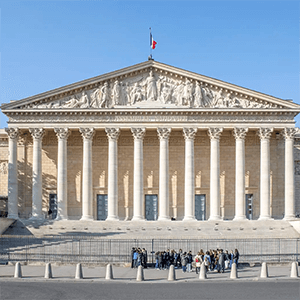
Valued at around €1.92 billion, the Palais Bourbon is Europe’s most expensive parliament building. It is situated in the 7th arrondissement of Paris, one of the city’s most prestigious and costly districts, where the average price of real estate is €15,500 per square metre. Built between 1722 and 1728 for Louise Françoise de Bourbon, Duchess of Bourbon and daughter of Louis XIV, the complex, together with the adjoining Hôtel de Lassay, spans 124,000 m² and contains more than 9,500 rooms. Its Neoclassical design features Corinthian columns, stucco sculptures, and Italian-inspired stonework. Confiscated during the French Revolution, it later became the seat of the National Assembly.
-
Palace of Westminster, London, England
Еstimated Market Price – €1,551,831,372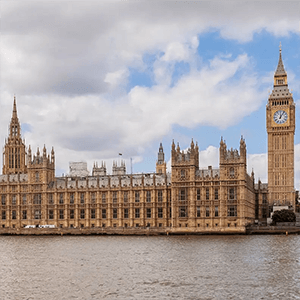
The Palace of Westminster, originally built as a royal residence for English kings, has been the home of Parliament since the 13th century. The complex contains more than 1,100 rooms, covering a gross floor area of 112,476 m², and is designed in the Perpendicular Gothic Revival style. Its most prominent feature, the Victoria Tower, rises to 98.5 metres. Construction of the current building began in 1876 following the devastating fire of 1834. The Palace is situated in central London, one of the city’s most prestigious and expensive districts, forming the heart of the UK government and political quarter. Property prices here are extremely high, averaging around €13,797 per square metre, which contributes significantly to Westminster’s estimated value of €1.55 billion.
-
Austrian Parliament Building, Vienna, Austria
Еstimated Market Price – €1,373,735,000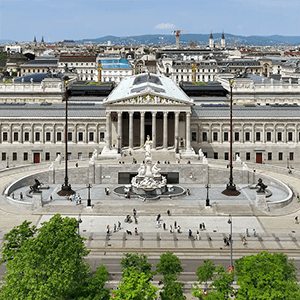
The Austrian Parliament Building, constructed between 1874 and 1883, was originally designed to house the Imperial Council of the Austro-Hungarian Empire. The complex comprises more than 100 rooms, including chambers, libraries, and even a gymnasium. Covering over 55,000 square metres of floor space, it is built in a Neoclassical, Greek Revival style using Austrian marble, bronze, and copper. The building is situated on the Ringstraße, one of Vienna’s most expensive locations, where real estate prices average an impressive €24,977 per square metre, giving the Parliament a substantial estimated value of €1.37 billion. Although it is relatively compact compared to other European parliament buildings, its central location and historical significance make it exceptionally valuable.
-
Parliament House, Stockholm, Sweden
Еstimated Market Price – €1,001,649,000
The Swedish Parliament House (Riksdag building) is located on Helgeandsholmen, a small island at the heart of Stockholm, within the historic Gamla Stan (Old Town) district. Real estate in this area averages €7,887 per square metre, giving the Swedish Parliament an estimated value of just over €1 billion. Constructed between 1897 and 1905, the building was originally designed to accommodate both the Riksdag (the Swedish parliament) and the Swedish National Bank. Covering a gross floor area of around 127,000 m², it combines Neoclassical architecture with Baroque Revival elements. In 1971, after Sweden transitioned to a unicameral system, the building underwent extensive rebuilding, with the former bank section converted into an Assembly Hall.
-
Palace of the Parliament, Bucharest, Romania
Еstimated Market Price – €751,535,000
Being the largest parliament building and the heaviest building in the world, the Romanian Palace of the Parliament would cost an estimated €751.5 million, due to Bucharest’s relatively low real estate prices of €2,059 per m². Situated in central Bucharest’s Civic Centre, an area redeveloped under Romania’s last communist leader, Nicolae Ceaușescu, the palace occupies a prestigious government district, yet the surrounding land remains comparatively inexpensive by European standards. The vast complex contains around 1,100 rooms and has a gross floor area of 365,000 m². Rising 84 metres above ground, with a further 92 metres below, it is designed in a Postmodern Neoclassical style with elements of socialist realism. Still, its construction, which took more than a decade, has been estimated to cost roughly €4 billion in today’s money.
-
Palacio de las Cortes, Madrid, Spain
Еstimated Market Price – €541,890,000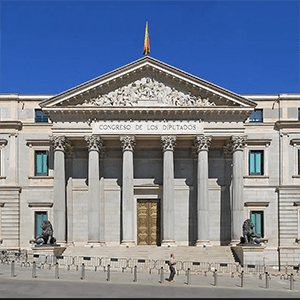
Valued at approximately €541.9 million (for the building alone), based on average real estate prices of €6,021 per m² along Madrid’s historic Carrera de San Jerónimo street, the Palacio de las Cortes serves as the home of Spain’s Congress of Deputies. Built between 1843 and 1850 under the liberal regime, it is executed in a Neoclassical style with Renaissance and Isabelline elements, using rusticated stone, Carrara marble, and bronze, and covers a gross floor area of around 90,000 m². Its façade features Corinthian columns and a pediment bas-relief, while the iconic bronze lions at the entrance were cast from war cannons. The building has been expanded several times, with ancient remains uncovered during renovations in 2009.
-
Reichstag Building, Berlin, Germany
Еstimated Market Price – €515,017,720
The Reichstag Building in Berlin was constructed between 1884 and 1894 to house the legislature of the German Empire. Covering 61,166 m² and standing 47 metres high, it is designed in a Neo-Renaissance style with Neo-Baroque influences, topped by a steel-and-glass cupola. Designed by Paul Wallot, the building was severely damaged in the 1933 fire and during the Second World War, and still bears wartime bullet holes and graffiti. It was famously wrapped by the artist Christo in 1995 and extensively redesigned by Norman Foster in 1999, who added the iconic glass dome. The inscription “Dem deutschen Volke” (“To the German People”) was added in 1916. With Berlin’s new-build real estate averaging €8,420 per m², the Reichstag would be valued at around €515 million; it is smaller but more valuable than Lisbon’s São Bento Palace.
-
São Bento Palace, Lisbon, Portugal
Еstimated Market Price – €470,439,000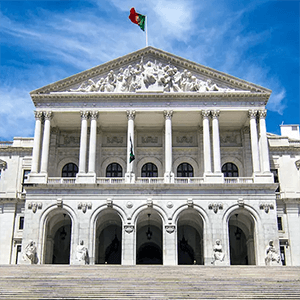
Valued at approximately €470.4 million, based on local real estate prices of €5,634 per m², the 83,500 m² São Bento Palace is similar in size to Spain’s Palacio de las Cortes, but less costly due to Portugal’s lower property values. Originally built as a Benedictine monastery, it now serves as the home of the Portuguese Parliament. Its architecture combines Mannerist origins with later Neoclassical features. The complex, which also houses the official residence of the Prime Minister, underwent major renovations that were completed by 1938, with smaller maintenance and restoration works continuing thereafter.
-
Binnenhof, The Hague, Netherlands
Еstimated Market Price – €396,000,000
Valued at approximately €396 million, the 90,000 m² Binnenhof is one of Europe’s least expensive parliaments, despite its size, especially compared with Vienna’s Austrian Parliament, which is nearly half its size but over three times as valuable. The Binnenhof, set in The Hague, where property prices average €4,400 per m², was originally built as a residence and hunting lodge for the Counts of Holland. Constructed mainly in the 13th century, it includes the Ridderzaal, completed under Floris V, and is characterised by Gothic architecture with later Neo-Gothic elements. Over the centuries, it became the heart of Dutch political life, serving as the centre of the Dutch Republic from 1584 onwards. Today it remains one of the world’s oldest parliament buildings still in use, housing the Torentje, the Prime Minister’s office since 1982, and the Trêveszaal, where cabinet meetings are held.
-
Palazzo Montecitorio, Rome, Italy
Еstimated Market Price – €294,660,000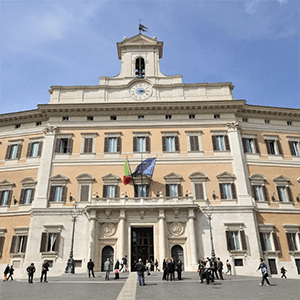
The Palazzo Montecitorio, located in the heart of Rome, was originally designed in the early 17th century for Cardinal Ludovico Ludovisi and completed under Pope Innocent XII. Built for public and social functions, the 36,000 m² complex features Art Nouveau (Liberty style) elements added during 1918 renovations, and is constructed from red brick and travertine. Designed by Bernini and later modified, it is named after the Roman hill on which it stands and formerly housed papal courts and police before becoming the Chamber of Deputies in 1870. With central Rome real estate averaging around €8,185 per m², the building’s estimated value is approximately €294.7 million.
Methodology
To identify the most expensive parliament buildings in Europe, we combined the floor area of each national legislature’s primary building with the average local prime real estate price per square metre in the city it is located in. Floor area data was sourced from government publications, architectural records, and supplementary sources such as Wikipedia, while real estate prices were drawn primarily from the Investropa platform and local property listing websites.
Where verified measurements were available, these were used directly. For buildings without official records of internal floor area, estimates were derived either by converting reported square footage into square metres or, where no published data existed, by calculating approximate measurements using Google Earth. In these cases, polygons were drawn around the building footprint, and total floor space was extrapolated based on the number of storeys. Parliament buildings without official square metre measurements in our ranking include the Palace of the Nation in Belgium, Leinster House in Ireland, Parliament House in Malta, the Riigikogu Complex in Estonia, the Seimas Palace in Lithuania, the House of Representatives Building in Cyprus, the House of the Livonian Noble Corporation in Latvia, and the National Assembly Building of Slovenia.
Each building’s estimated market value was calculated by multiplying its size by the local property rate, producing a consistent measure that allows comparisons across countries. While this method does not capture unique historical or cultural value, it provides a hypothetical estimate of the financial worth of Europe’s parliamentary landmarks based on local real estate costs.